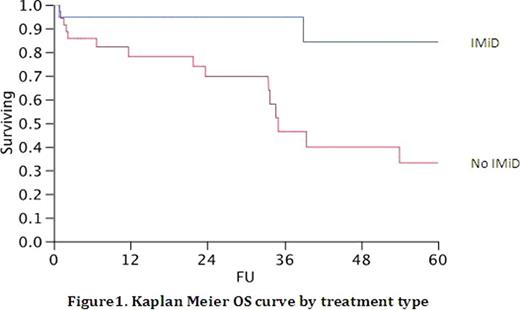Abstract
Abstract 1808
Approximately 50% of the Multiple Myeloma (MM) cases are associated with hyperdiploidy (Hyperdiploid MM, HDMM), usually of the odd numbered chromosomes. The majority of the remaining patients with MM have translocations involving the immunoglobulin heavy chain (IgH) locus on chromosome 14q32 (Translocated MM, TMM).(Fonseca R, Leukemia 2009;23:2210-21)
However, most of these estimates are from studies done in predominantly white populations. MM is approximately two fold more common in blacks, and results from the phase 3 study of lenalidomide and dexamethasone suggested that blacks may have better outcome. (Rajkumar SV, Lancet Oncol 2010;11(1):29-37)
The purpose of this study was to determine the cytogenetic characteristics and outcome of MM in blacks, and to compare this with a similar population of white patients seen during the same time period.
We studied African American and African patients with MM diagnosed from May 2002 through June 2010 at John H. Stroger, Jr. Hospital of Cook County (CC), Chicago, IL and comparable Caucasian population seen at Mayo Clinic (MC), Rochester, MN between these dates with available cytogenetic studies (karyotyping and/or fluorescent in situ hybridization (FISH) data) at diagnosis. The results between both populations were then compared.
65 blacks (25 men and 40 women) and 490 Caucasians (290 men and 200 women) with MM were studied. Karyotyping was available in 98% of patients from both cohorts, and FISH was available for 35% and 64% of the CC and MC cohorts, respectively. A molecular classification was possible in 16 (25%) of the CC cohort (12 HDMM, 4 TMM) and 294 (60%) of the MC cohort (38% HDMM, 22% TMM). In the remaining patients, both tests were normal or showed changes not definitive for either IgH translocations or hyperdiploidy. At diagnosis, abnormal cytogenetics by karyotyping was present in 25/65 (38%) of the CC cohort and 154/479 (32%) of the MC cohort. The median overall survival (OS) from diagnosis for the CC and MC cohorts was similar at 64 months. The median OS was significantly shorter for those with an abnormal cytogenetics; 35 months vs. 65 months in the CC cohort (P0.03) and 49 months vs. not reached for the MC cohort (P < 0.01). OS was superior among patients in the CC cohort initially treated with an immunomodulatory agent (IMiD) containing regimen (65 months vs. 35 months for those receiving a bortezomib or other non-IMiD containing regimens (P=0.02; Figure 1). Similarly, in the MC cohort, patients receiving an IMiD based regimen had a superior OS (not reached vs. 42 months; P < 0.001). The use of immunomodulatory therapy did not differ across cytogenetic types.
The current study suggests that IgH translocations were less frequently seen in blacks compared with what is typically reported in the literature. This may explain the relatively better survival reported in blacks compared with whites in recent trials. We found a significantly superior outcome in blacks treated initially with regimens containing immunomodulatory agents compared to other regimens.
No relevant conflicts of interest to declare.
Author notes
Asterisk with author names denotes non-ASH members.


This feature is available to Subscribers Only
Sign In or Create an Account Close Modal